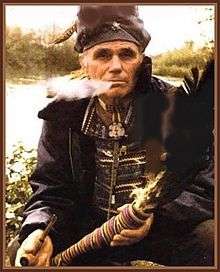Rolling Thunder (person)
Rolling Thunder (birth name: John Pope, 1916–1997) was a hippy spiritual leader who self-identified as a Native American medicine man.[3] He was raised in Oklahoma and later moved to Nevada.[4]
Rolling Thunder | |
|---|---|
 | |
| Born | John Walter Pope September 10, 1916 Stamps, Arkansas, US |
| Died | January 23, 1997 (aged 80) Elko, Nevada, US |
| Nationality | American |
| Known for | New Age spiritualist |
| Spouse(s) | Spotted Fawn (her death 1984) [1]Carmen Sun Rising (his death 1997) [2] |
| Children | Mala Spotted Eagle Buffalo Horse Ozella Morning Star Patty Mocking Bird[1] |
In print
John Pope has been the subject of several books, notably Rolling Thunder (1974), by American journalist and author Doug Boyd, and the book Rolling Thunder Speaks: A Message for Turtle Island (1998), a narrative edited by his second wife, Carmen Sun Rising Pope. He also figures prominently in Mad Bear (1994), Boyd's follow-up book to Rolling Thunder, which chronicles the life of Mad Bear Anderson, who Boyd says was a peer and mentor to Rolling Thunder.[4]
In music
Pope appears on Grateful Dead drummer Mickey Hart's 1972 album Rolling Thunder. His voice is heard on the first track of Side A: "Rolling Thunder/Shoshone Invocation". In 1975/76, Bob Dylan organized and headlined a nationwide series of concerts called the Rolling Thunder Revue. In the film Rolling Thunder Revue: A Bob Dylan Story by Martin Scorsese, Bob Dylan states “This tour was named after chief Rolling Thunder”.[5]
On audio cassette
Rolling Thunder appears in taped interviews with John Trudell and Michael Chosa in which he describes the contemporary treatment of Native Americans.[6]
Life and legacy
In 1975 he and his wife Spotted Fawn founded a non-profit community on 262 acres (1.06 km2) of land in north-eastern Nevada (just east of the town of Carlin) that they named Meta Tantay. It operated until 1985; visitors over the years included Mickey Hart.[7]
Death
Rolling Thunder died in 1997 from complications associated with diabetes. He also suffered from emphysema in the later years of his life.[4]
Controversy
Rolling Thunder's given name was John Pope.[8] At times he claimed to be part Cherokee[8] and at other times Shoshone[9] or Hopi.[10] He never provided proof of any Native heritage. He has been accused of cultural appropriation and cited as an example of a non-Native who taught fraudulent, "Native-style" ceremonies, often for money.[11][12] He often claimed to represent the Western Shoshone Nation.[9]
Bibliography
- Native Healer: Initiation Into an Ancient Art by Bobby Lake-Thom and Robert G. Lake – 1991 (Foreword by Rolling Thunder) Quest Books ISBN 978-0-8356-0667-7
Discography
- Rolling Thunder – Mickey Hart (1972)
- Rolling Thunder Speaks: the Owyhee Confrontation (Audio Book)
- From Alcatraz to Chicago - with John Trudell and Michael Chosa (Audio Book)
Video
- A Day with Rolling Thunder at Meta Tantay (1978) Produced by Al Licari and United Earth Fund http://unitedearthfund.org/rollingthunder.html
Filmography
- Rolling Thunder: Healer of Meta Tantay – UFO TV – DVD Release Date: February 22, 2005
Notes
- Laszlo, Ervin (February 12, 2009). The Akashic Experience: Science and the Cosmic Memory Field. Inner Traditions. ISBN 1594772983.
- The Shamanic Powers of Rolling Thunder: As Experienced by Alberto Villoldo, John Perry Barlow, Larry Dossey, and Others. Bear & Company. ISBN 1591432278.
- Mystics, Magicians, and Medicine People: Tales of a Wanderer
- Rolling Thunder Speaks
- Rolling Thunder Revue: A Bob Dylan Story, Netflix,
This tour was named after chief Rolling Thunder. So it made sense that we go to the Tuscarora Indian Reservation and play.
- http://www.worldcat.org/title/from-alcatraz-to-chicago/oclc/5578494
- Mickey Hart at Meta Tantay
- Panther-Yates 40
- Rolling Thunder speaks : the Owyhee confrontation
- History and Culture of the Boise Shoshone and Bannock Indians. Dorrance Publishing. ISBN 978-1-4349-5470-1.
- G. Hobson, "The Rise of the White Shaman as a New Version of Cultural Imperialism." in: Hobson, Gary, ed. The Remembered Earth. Albuquerque, NM: Red Earth Press; 1978: 100-108.
- Chidester, David, Authentic Fakes: Religion and American Popular Culture. University of California Press; 2005; p.173: "Defenders of the integrity of indigenous religion have derided New Age shamans, as well as their indigenous collaborators, as 'plastic shaman' or 'plastic medicine men.'"
References
- Ivakhiv, Adrian J. Claiming Sacred Ground: Pilgrims and Politics at Glastonbury and Sedona. Indiana University Press, 2001. ISBN 978-0253338990.
Further reading
- The Shamanic Powers of Rolling Thunder: As Experienced by Alberto Villoldo, John Perry Barlow, Larry Dossey, and Others by Sidian Morning Star Jones and Stanley Krippner, Ph.D. (editors) - Bear & Company (November 2016) ISBN 978-1591432272
- The Voice of Rolling Thunder: A Medicine Man's Wisdom for Walking the Red Road by Sidian Morning Star Jones and Stanley Krippner, Ph.D. (editors) - Bear & Company (September 2012) ISBN 978-1591431336
- Dream Catchers: How Mainstream America Discovered Native Spirituality By Philip Jenkins (2005) Oxford University Press ISBN 978-0-19-518910-0. 2004.
- Hollywood and the Supernatural by Sherry Hansen and Brad Steiger – St. Martin's Press (1990).
- Mad Bear: Spirit, Healing, and the Sacred in the Life of a Native American Medicine Man by Doug Boyd (1994) Touchstone
- Mystics, Magicians, and Medicine People: Tales of a Wanderer by Doug Boyd – Marlowe & Co (1995) ISBN 978-1-56924-880-5
- Personality Theories: Critical Perspectives by Albert Ellis, Mike Abrams and Lidia Abrams (2008) Sage Publications, Inc. ISBN 978-1-4129-1422-2
- Rolling Thunder: A Personal Exploration into the Secret Healing Powers of an American Indian Medicine Man by Doug Boyd – Delta (1976) ISBN 978-0-385-28859-0